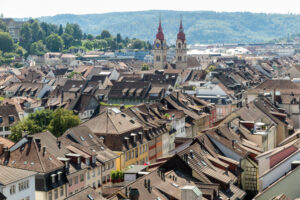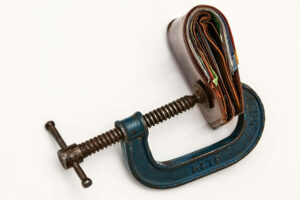
The Winterthur Coin Cabinet is a very special treasure. Lovers of ancient coins know that the museum houses a large portion of its first curator’s collections, the renowned numismatist Friedrich Imhoof-Blumer. In 1871, the latter bequeathed his collection of Swiss coins with more than 10,000 specimens to the city of Winterthur, and many of his ancient coins are also kept at the museum. Since then, the Coin Cabinet has grown and contains about 63,000 numismatic objects by now. Anyone who has visited the Coin Cabinet will rave about the exhibition and – what’s more – about the building itself. Since 1982, the Coin Cabinet has no longer been part of the City Library. It is an independent museum located in the magnificent Villa Bühler.
Due to this historical development, the Coin Cabinet is the only Swiss numismatic collection that is also an independent museum – and that’s a costly affair for the city of Winterthur. This situation led to a so-called motion, i.e. a procedural request of the city parliament to the city council, asking them to examine other forms of funding.

What Is the Parliamentary Motion on the Winterthur Coin Cabinet About?
At the heart of the matter is this question: who shall fund the Winterthur Coin Cabinet? The motion indicates that the annual cost amounts to about CHF 700,000. In contrast, those who submitted the motion consider the “interest of the public to be very small” and think that the museum is “mainly of interest to a limited, specific, national and international public (of experts)”. At the same time, it’s “the only numismatic collection in Switzerland operating as an independent unit that is not part of a larger museum or an archive.”
At first, this sounds like one of the usual austerity measures that politicians like to impose on institutions that don’t make enough money. In fact, the motion does not mention that the museum significantly increased self-funding in recent years, as the Museum Director Benedikt Zäch explained to CoinsWeekly. According to Zäch, who is also a member of the Winterthur city parliament, the importance of the museum should not only be based on the number of visitors. The other activities of the Coin Cabinet must also be taken into account, especially the broad educational work, which “is met by above average demand”, and the recently started project of digitizing the collection.
Nevertheless, this motion must be taken seriously and it shouldn’t be dismissed as a culture-ignoring disturbance. The question of whether a single municipality can pay for such a museum by itself is justified. After all, institutions with a superregional, even international focus aren’t usually funded by a municipality.
Should the Winterthur Coin Cabinet Simply Save Money?
In 1994 a similar motion concerning the Winterthur Coin Cabinet was submitted. Benedikt Zäch had taken over his position as Museum Director just one year earlier and recalls the fundamental difference between the two motions: “The 1994 procedural request was a motion too, but it clearly demanded that the museum be ‘spun off’ or closed. The new motion does expressly not demand neither. It’s also striking that the debate did not question the museum’s importance.”

So, Who Is to Pay?
What are the alternatives? It would be possible to include the Coin Cabinet in the cantonal museum, as is the case with most Swiss numismatic collections. But Benedikt Zäch points out that the canton of Zurich does not have a cantonal museum to begin with. The explicit collecting focus of the Swiss National Museum in nearby Zurich (which is not funded by the canton) is Switzerland. But the Winterthur Coin Cabinet focuses on coins that are not thematically related to Switzerland. Moreover, there are legal obstacles to a direct sale – the most important collections of the Coin Cabinet, the Imhoof-Blumer, Hüni and Tobler Collections, were given to the city of Winterthur as inalienable donations, as the Museum Director Zäch emphasises.
But even Zäch is not completely opposed to another form of funding. Currently, the Coin Cabinet is an “administrative department” of the city, which isn’t really helpful for day-to-day business. In any case, due to the regulations regarding the donated collections the city would still have to be primarily responsible for the museum – and would thus not necessarily save money.
A more realistic option seems to be the financial support by the canton or a foundation. But before specific steps can be considered, the city council has to deliver a statement on the possibilities and the museum’s current situation by the end of September 2022. Then there are two options. Either a majority of the parliament does not consider it necessary to take action. Or a simple majority adopts a so-called declaration of relevance. In that case, the city council has to develop a proposal for implementation, i.e. lay out alternative ideas for funding the museum. This could take up to 18 months – and this deadline might even be extended as the experienced parliamentarian Benedikt Zäch explains. The motion itself will now initiate a political stocktaking and show the position of the museum.
The Winterthur Coin Cabinet in 2022
The Coin Cabinet certainly does not have a need to hide! Apart for the usual exhibition and educational work, it received an important medal collection on long-term loan in the spring of 2022, which will be thoroughly examined by scholars.
In addition, the digitization of the coin collection is coming along and the long-awaited third volume of “Griechische Münzen in Winterthur” (Greek coins in Winterthur) has now been published.
So, unlike in 1994, this is not a matter of life and death for the Winterthur Coin Cabinet. Even parliamentarians who aren’t interested in coins recognize the international importance of the Coin Cabinet 25 years after the first motion. This is certainly a remarkable achievement of the museum. It’s legitimate to ask whether a different form of funding might even have advantages for the museum and research activities of this important Swiss institution.
Here you can find the website of the Winterthur Coin Cabinet.
If you want to support the Coin Cabinet, you can become a member of their sponsors’ association.



